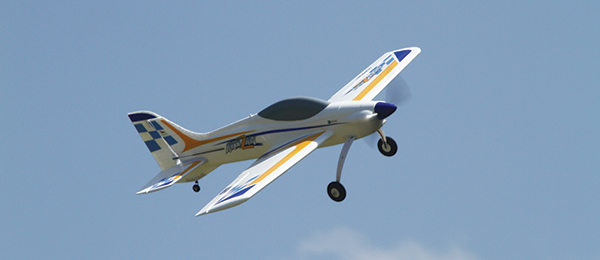 Review by Greg Gimlick
An enjoyable grab-and-go sport model
Abridged review and flight video
Read the complete review in the August 2014 issue of
Review by Greg Gimlick
An enjoyable grab-and-go sport model
Abridged review and flight video
Read the complete review in the August 2014 issue of Model Aviation.
Specifications
Model type: Sport aerobatic ARF
Skill level: Intermediate builder; intermediate pilot
Wingspan: 42.5 inches
Wing area: 383 square inches
Airfoil: Symmetrical
Length: 40 inches
Flying weight: 34.5 ounces
Recommended power system: Park 480 960 Kv brushless outrunner; 30-amp brushless ESC; 11.1-volt 3S 1,800-2,200 mAh LiPo; 10.75 x 8 propeller
Radio: Four-channel; four micro servos
Construction: Z-Foam construction
Street price: $249.99 (BNF); $184.99 (PNP)
Test-Model Details
Radio system: Spektrum DX9 transmitter; three ParkZone PKZ1081 servos; one ParkZone PKZ1090 servo; Spektrum AR635 six-channel sport receiver (includes AS3X); E-flite 30-amp Pro Switch-Mode BEC ESC; E-flite 11.1-volt 3S 1,800 mAh 30C LiPo
Flying weight: 32.2 ounces
Motor: ParkZone 480 960 Kv brushless outrunner motor
ESC: 30-amp Pro Switch-Mode BEC Brushless ESC (V2)
Battery: E-flite 11.1-volt 3S 1,800 mAh 30C LiPo
Propeller: ParkZone 10.75 x 8
Flight duration: 5-8 minutes
Pluses
• Ease of assembly.
• Spare screws included.
• Ready to fly in less than an hour.
• Packaged to withstand the roughest shipping.
• Canopy access and latch.
• Airfoil turbulators.
• Good power setup.
• The AS3X!
Minuses
• Instruction error for installing tail surface.
• ESC battery plug wire could be slightly longer.
Abridged Review
The first thing that hit me when I opened the shipping box was how perfectly the airplane was packed. The Styrofoam box inside a display carton, inside a double-walled shipping box, ensured that the gouges and bruises on the outside box didn’t affect the contents. Whoever designed the airplane was a smart person, but whoever designed the foam shipping box had his or her own touch of brilliance.
After I got it all out of the box, it was easy to see that this would be a quick build. I found the included battery and charger and got the battery charging so it would be ready when I was.
I almost feel guilty using the word construction. My version was a Bind and Fly (BNF), so everything was installed. It needed a short assembly time, roughly 45 minutes, and it only required a Phillips screwdriver.
I used the recommended throws and CG, which worked well. There are no specific throws designated in terms of degree or measurement. They are set at maximum and tuned down by the settings of your dual-rate switch. The throws suggest 100% and 70% and that worked fine, along with my typical exponential setting of 25%.
I’ve used this system in some other airplanes and it has always impressed me. The ArtiZan comes with the AS3X preinstalled and programmed for the optimum settings with this setup. There is a full instruction manual for the AR635 receiver in case you want to change something, but don’t make the mistake of doing that before flying the airplane first. It was perfectly set for my version of the kit.
Remember that this is not a 3-D airplane. It is highly aerobatic and can be made even more so by adjusting the CG and control throws, but it’s intended to be an excellent second airplane for someone progressing to aerobatics from a trainer.
It loves to fly inverted and requires little elevator to do so. It will also easily fly from inverted to upright by doing an outside loop halfway and stopping. If you want, you can continue that outside loop all the way around for fun.
This is a great little aerobatic airplane. It quickly goes together and the provided power package does a great job. I like having a “grab and go” airplane that is cheap to outfit with multiple 3S packs and easy to transport. It looks good in the sky and the AS3X system makes you look like a better pilot.
I suggest that you begin with the low rates and progress to high rates when you’re familiar with it. It’s controllable on the suggested high rates, but very aerobatic. I was glad I set up the middle rate to expand the range.
Did I mention that I love this aircraft? I can’t think of a better airplane to help fine-tune your aerobatics. If you’re new to the sport, this one will serve you well and grow with you.[
Read the complete review in the August 2014 issue of
Model Aviation.
Greg Gimlick
Flight Video


Add new comment